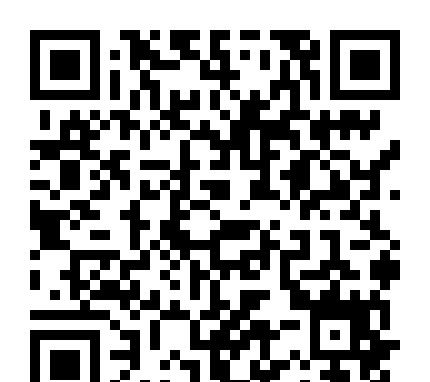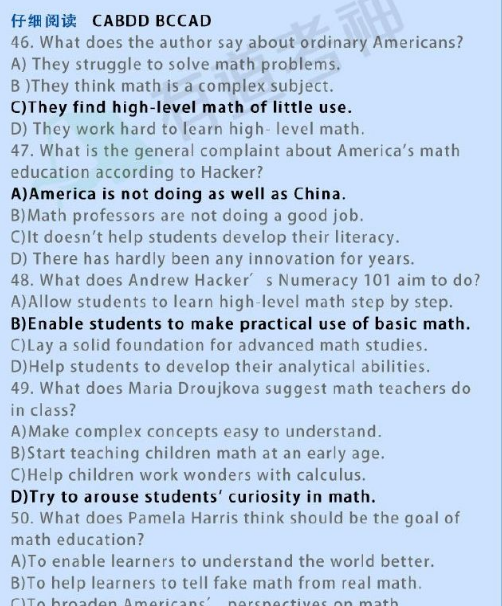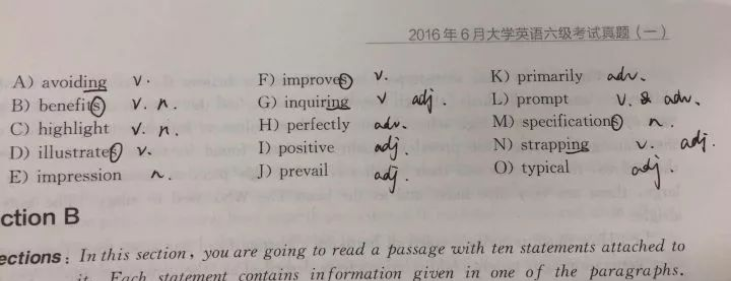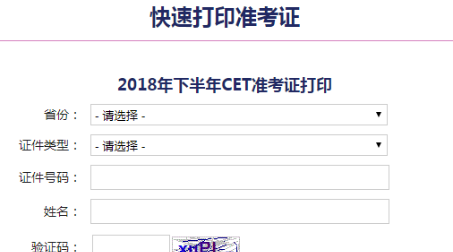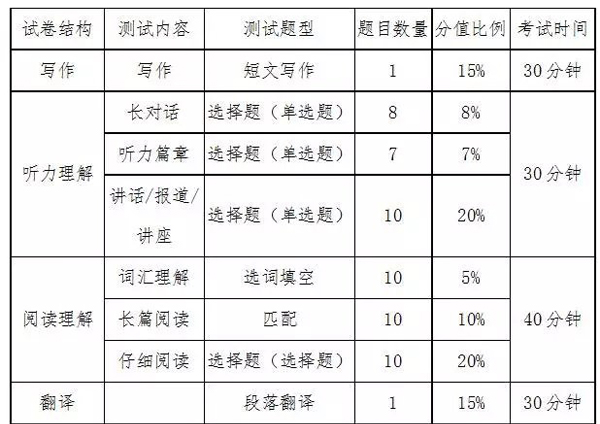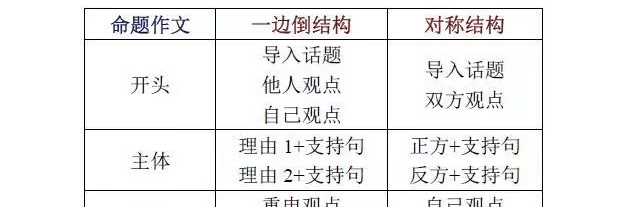全国英语等级考试三级全真模拟试题四b
|
Part B You are going to hear four conversations. Before listening to each conversation, you will have 5 seconds to read each of the questions which accompany it. After listening, you will have time to answer each question by choosing A, B, C or D. You will hear each passage or conversation ONLY ONCE. Mark your answers in your test booklet. Questions 11 -14 are based on the following conversation. You now have 20 seconds to read the questions 11 - 14. 11 . Why did the man ' s children buy the pen? [A] It's a present for the man' s birthday. [B] It's a birthday present for the man' s wife. [C] It's a birthday present for the man' s son. [D] It's a birthday present for the man ' s daughter. 12. What's the color of the pen? [A] Red. [B] Black. [C] Yellow. [D] Purple. 13. How much is the pen? [A] $11. [B] $14. [C] $9. [D] $10. 14. Why did the man want to exchange the pen? [A] Because of the color. [B] Because it is too expensive. [C] Because it is too cheap. [D] Because it doesn't work. You now have 40 seconds to check your answers to questions II -14. Questions 15 -17 are based on the following talk. You now have 15 seconds to read the questions 15-17. 15. Who is the speaker? [A] A librarian. [B] A professor. [C]A researcher. [D]A student. 16. For whom is the course intended? [A] All second-year students who failed first-year English. [B] All first-year, second-year, and third-year students. [ C ] Students who don ' t know how to write a research paper. [ D ] Students who want extra credit in English. 17. What does the speaker ask the students who have already learned to write a research paper to do? [A] Take notes. [B] Help the other students. [C] Speak to her after class. [D] Enroll in another English class. You now have 30 seconds to check your answers to questions 15-17. Questions 18-21 are based on the following conversation. You now have 20 seconds to read the questions 18 -21. 18. When does the conversation take place? [A] In the middle of the semester. [ B] At the beginning of exams. [C] At the end of the school year. [D] In the middle of summer vacation. 19. Where do Bob and Ellen want to go? [A] To a rock and mineral show. [B] To an opera at the concert hall. [ C] To a movie at the student center. [D] To a popular music concert. 20. Why is Ellen buying the tickets? [A] She gets a student discount. [B] Bob doesn't have much money. [C] She lost a bet and owed Bob money. [D] Bob left his wallet at home. 21. What is Bob going to pay for? [A] His ticket only. [B] Their vacation. [C] His supper only. [D] Their supper. You now have 40 seconds to check your answers to questions 18 -21. Questions 22 - 25 are based on the following conversation. You now have 20 seconds to read the questions 22 -25. 22. What is the woman looking for? [A] The bookstore. [B] The telephone company. [C]A map of the town. [D]A shoe repair shop. 23. What can be said about the way the man teaches the woman? [ A ] He seems to be in a hurry to leave. [B] He seems to be curious about her. [ C] He seems to be happy to assist her. [ D] He seems to be unfamiliar with the town. 24. Which source of information about the town does the man recommend to the woman? [A] A guidebook. [B] A police report. [C] The newspaper. [D] The telephone company. 25. Where is the shoe shop? [A] Right down the street. [B] Next to a bookstore. [C] About four blocks away. [D] Across town. You now have 40 seconds to check your answers to questions 22 -25. Now you have 1 minutes to transfer your answers from your test booklet to the ANSWER SHEET 1. That is the end of the listening comprehension section. Section I Use of English (15 minutes) Directions: Read the following text. Choose the best word or phrase for each numbered blank and mark A, B,C, or D on your ANSWER SHEET 1. Text Many teachers believe that the responsibilities for learning lie with the students. 26 a long reading assignment is given, instructors expect students to be familiar with the 27 in the reading even if they do not discuss it in class or take an examination. The 28 student is considered to be 29 who is motivated ( 散发) to learn for the sake of 30 , not the one interested only in getting high grades. Sometimes homework is returned 31 brief written comments but without a grade. Even if n. grade is not given, the student is 32 for learning the material assigned. When research is 33 , the professor expects the students to take it actively and complete it with 34 guidance. It is the 35 responsibility to find books, magazines, and articles in the library. Professors do not have the time to explain 36 a university library works; they expect students, 37 graduate students, to be able to exhaust the reference' 38 in the library. Professors will help students who need it, but 39 that their students should not be 40 dependent on them. In the United States professors have many other duties 41 teaching, such as administrative or research work. 42 , the time that a professor can spend with a student outside of class is 43 .If a student has problems with classroom work, the student should either 44 a professor during office hours 45 make an appointment. 26. [A] If [B] Although [C] Because [D] Since 27. [A] suggestion [ B ] context [ c ] abstract [ D ] information 28. [AJ poor [B] ideal [C] average [D] disappointed 29. [A] such [B] one [C] any [D] some 30. [A] fun [B] work [G] learning [D] prize 31. [A] by [B]in [C] for [D] with 32. [A] criticized [B] innocent [C] responsible [D] dismissed 33. [A] collected [B] distributed [C] assigned [D] finished 34. [A] maximum [B] minimum [C] possible practical 35. [A] student's [B] professor's [G] assistant's [D] librarian's 36. [A] when [B] what [C] why [D] how 37. [A] particularly [B] essentially [C] obviously [D] rarely 38. [A] selections [B] collections [C] sources [D] origins 39. [A] hate [B] dislike [C] like [D] prefer 40. [A] too [B] such [C] much [D] more 41. [A] but [B] except ' [C] with [D] besides 42 .[A] However [B] Therefore [C] Furthermore [D] Nevertheless 43. [A] plentiful [B] limited [C] irregular [D] flexible 44. [A] greet [B] annoy [C] approach [D] attach 45. [A] or [B] and [C] to [D] but |

